
Have you ever thought about the difference between “understanding” and “knowing?” It’s very easy to assume that these two words have the same meaning, but we believe there is some nuance distinguishing them.
“Understanding” can refer to a state beyond simply “knowing” a concept. Itself, “knowing” a concept implies a familiarity with an idea, but perhaps not a working knowledge of it. For example, we can “know” about airplanes, but we might not have a comprehensive understanding of how they work. It’s very easy to know a concept without truly understanding it.
For Japan Math, this is a very important distinction and one we hope to combat with our programs and teaching methods. We believe our students need to not simply “know” a concept, but have a deep “understanding” that allows them to apply the concepts and skills they’ve learned to even the most unfamiliar problems. Through our curriculum, we are creating a foundation of “understanding” our students that exceeds simply “knowing” a concept.
Try, Understand, Apply, Master
We believe in the importance of “understanding” a concept so much, it’s a core step of our program’s process! Every Japan Math unit takes students through the same process:
- They try to solve a new problem with skills and concepts they’ve previously learned.
- They understand the new concept of the unit.
- They apply it to several different types of problems, ensuring they understand the new concept fully.
- The students then work on advanced problems involving not only this new concept, but involving concepts from previous units, Through this practice, the new concept is mastered!
Here’s an example:
Say a group of students are using a formula to find the area of a trapezoid. These students may technically know the formula for finding the area of a trapezoid and be able to recite it when the teacher asks them, but this is different from understanding the formula. Memorizing a formula does not demonstrate an understanding of its possible uses.
When a student is asked to apply the formula they simply “know” and don’t understand, they may struggle to do so. For example, if the problem changes the orientation of a trapezoid, a student without a working understanding of the formula may easily mistake the hypotenuse as the base.
Our goal with Japan Math is to ensure that they properly understand the concepts they’re learning and are able to apply these strategies to a variety of different problems.
Continuing with our example, students who sufficiently understand how to find the area of a trapezoid can also respond to the question –
"Why does that formula work?"
In order to explain their answer, they’ll be required to understand the concept. They will have to recall the concept of "parallel" and "height," how to find the area of triangles and squares, and general strategies that they’re previously learned.
It will require a working understanding of other concepts they’ve learned before, which brings us to Japan Math’s ultimate target – to create strong problem-solving and mathematical skills through building on the concepts they’ve learned before.
Understanding and knowing are often used interchangeably in today’s society, but at Japan Math, we believe there is a strong difference between the two, and we will continue aid our students in their mathematical understanding, not just in their knowledge.
When students are actively involved in making sense of mathematics tasks using varied strategies, justifying solutions and making connections to prior knowledge and experiences, they are building on concepts they have already mastered and learning to “understand” instead of simply “know.”
More from our blog:
Try and the Role of the Teacher
What’s the Difference Between Japan Math and Singapore Math?
